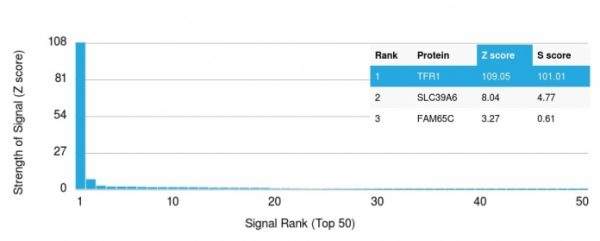Human Anti-CD71 / Transferrin Receptor (TFRC) (Extracellular Domain) Antibody Product Attributes
Species: Human
Tested Applications: ELISA, WB, IHC.
Clonality: Monoclonal
Anti-CD71 / Transferrin Receptor (TFRC) (Extracellular Domain) Antibody Clone: TFRC/1839
Clone TFRC/1839 Host and Isotype: Mouse IgG2b, kappa
Anti-Human CD71 / Transferrin Receptor (TFRC) (Extracellular Domain) Positive Control Sample: Jurkat, HeLa, MCF-7 or K562 cells. Human placenta or Bone Marrow.
Cellular Localization of Antibody TFRC/1839 Staining: Cell surface
Buffer and Stabilizer: 10mM PBS with 0.05% BSA & 0.05% azide. Also available without BSA & Azide.
Antibody Concentration: 200 ug/ml
Antibody Purification Method:Protein A/G purified from Bioreactor concentrate.
Immunogen: Recombinant human extracellular TFRC protein fragment (apprx. aa 94-212) (Please call for additional information.)
Storage Conditions: Store at 2 to 8 C (refrigerate). Stable for 24 months when properly stored.
CD71 / Transferrin Receptor (TFRC) (Extracellular Domain) Previously Observed Antibody Staining Patterns
Observed Subcellular, Organelle Specific Staining Data:
Anti-TFRC antibody staining is expected to be primarily localized to the endosomes and lysosomes.Observed Antibody Staining Data By Tissue Type:
Variations in CD71 / Transferrin Receptor antibody staining intensity in immunohistochemistry on tissue sections are present across different anatomical locations. An intense signal was observed in hematopoietic cells in the bone marrow and trophoblastic cells in the placenta. More moderate antibody staining intensity was present in hematopoietic cells in the bone marrow and trophoblastic cells in the placenta. Low, but measureable presence of CD71 / Transferrin Receptor could be seen inlymphoid tissue in appendix, glandular cells in the breast, myoepithelial cells in the breast, respiratory epithelial cells in the bronchus, neuronal cells in the caudate nucleus, cells in the granular layer in cerebellum, neuronal cells in the cerebral cortex, squamous epithelial cells in the cervix, uterine, glandular cells in the endometrium, epididymis and gallbladder, myocytes in heart muscle, hepatocytes in liver, respiratory epithelial cells in the nasopharynx, follicle cells in the ovary, ovarian stroma cells in the ovary, exocrine glandular cells in the pancreas, islets of Langerhans in pancreas, glandular cells in the parathyroid gland and prostate, keratinocytes in skin, melanocytes in skin, glandular cells in the small intestine, smooth muscle cells in the smooth muscle, peripheral nerve in mesenchymal tissue, glandular cells in the stomach, Leydig cells in the testis and non-germinal center cells in the tonsil. We were unable to detect CD71 / Transferrin Receptor in other tissues. Disease states, inflammation, and other physiological changes can have a substantial impact on antibody staining patterns. These measurements were all taken in tissues deemed normal or from patients without known disease.Observed Antibody Staining Data By Tissue Disease Status:
Tissues from cancer patients, for instance, have their own distinct pattern of CD71 / Transferrin Receptor expression as measured by anti-CD71 / Transferrin Receptor antibody immunohistochemical staining. The average level of expression by tumor is summarized in the table below. The variability row represents patient to patient variability in IHC staining.| Sample Type | breast cancer | carcinoid | cervical cancer | colorectal cancer | endometrial cancer | glioma | head and neck cancer | liver cancer | lung cancer | lymphoma | melanoma | ovarian cancer | pancreatic cancer | prostate cancer | renal cancer | skin cancer | stomach cancer | testicular cancer | thyroid cancer | urothelial cancer |
|---|---|---|---|---|---|---|---|---|---|---|---|---|---|---|---|---|---|---|---|---|
| Signal Intensity | ++ | - | ++ | ++ | ++ | ++ | +++ | + | + | + | + | ++ | + | - | - | ++ | - | - | - | ++ |
| TFRC Variability | ++ | + | ++ | + | ++ | ++ | + | ++ | +++ | ++ | ++ | ++ | ++ | + | ++ | ++ | ++ | + | ++ | ++ |
Limitations and Warranty
enQuire Bio's product, CD71 / Transferrin Receptor (TFRC) (Extracellular Domain) MonoSpecific Antibody, is available for Research Use Only (RUO-Only). This antibody is guaranteed to work for a period of two years when properly stored.






There are no reviews yet.